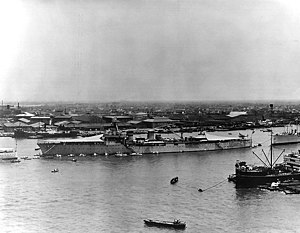Service history
Completed in 1927, Lamotte-Picquet was based at Brest until 1933, serving with the 3rd Light Division, of which she was flagship. In 1935, she was sent to the Far East, where at the outbreak of war in 1939, she patrolled around French Indochina and the Dutch East Indies.
After the French surrender in Europe, tension developed along the border with Siam (now Thailand). These flared into hostilities between Siam and Vichy France in December 1940. In January 1941, Lamotte-Picquet became the flagship of a small squadron, the Groupe Occasionnel. It was formed on 9 December at Cam Ranh Bay, near Saigon, under the command of Capitaine de Vaisseau Bérenger. The squadron also consisted of the colonial sloops Dumont d'Urville and Amiral Charner , and the older sloops Tahure and Marne. The Groupe Occasionnel with Lamotte-Picquet at its head, met a Thai squadron of two torpedo boats and the coastal defence ship HTMS Thonburi in the Battle of Koh Chang on 14 January 1941.
The Thai squadron was defeated, with both torpedo boats sunk and the coastal defence ship run aground. The Lamotte-Picquet suffered insignificant damage during the engagement, and also retreated after her victory over the Thai Navy. There had been several minor contesting claims against the official report of no damage, including a reference book Janes Fighting Ships (1955 edition).
The victory was for naught, however, as the Japanese forced a settlement in the Franco-Thai War in favour of the Thais. Apart from a visit to Osaka, Japan in September 1941, Lamotte-Picquet was thereafter restricted in her activities. From the next month, Lamotte-Picquet was used as a training hulk.
She was sunk in Đồng Nai River, on 12 January 1945, by U.S carrier based aircraft from Task Force 38 during the South China Sea raid. The remains of the hull were scrapped after the war. [2]
Four ships of the French Navy have been named in honour of the 18th century admiral count Toussaint-Guillaume Picquet de la Motte.

Primauguet was a French Duguay-Trouin-class light cruiser built after World War I. During the Anglo-American invasion of French North Africa in 1942, she was burnt out and abandoned, having been subject to gunfire from a fleet led by the battleship Massachusetts, and repeated aerial attacks by SBD Dauntless dive bombers. She was named after the 15th century Breton captain Hervé de Portzmoguer, nicknamed "Primauguet".

The Battle of Ko Chang took place on 17 January 1941 during the Franco-Thai War in which a flotilla of French warships attacked a smaller force of Thai vessels, including a coastal defence ship. The battle resulted in a tactical victory by the French Navy over the Royal Thai Navy although the strategic result is disputed. The Japanese intervened diplomatically and mediated a ceasefire which was in Thailand's favor as all disputed territories in French Indochina were ceded by Vichy France to Thailand. In the end, two Thai ships were sunk and one was heavily damaged. Within a month of the engagement, the French and the Thais negotiated a peace which ended the war.

The Duguay-Trouin class were the first major French warships built after World War I. They were excellent steamers and proved successful and seaworthy over a quarter century of service. All three achieved 33 knots on trials and could easily maintain 30 knots in service. Twenty-year-old Duguay-Trouin could still maintain 27.7 knots at her post-war displacement of 10,900 tons. They were fast and economical, although with a limited range. The fate of these three ships after the French surrender illustrates the dichotomy within the French armed forces at the time: one ship was interned, then joined the Free French, another twice resisted Allied bombardment and was destroyed, and the third was disarmed at a French colonial port and subsequently sunk.

Duguay-Trouin was the lead ship of her class of French light cruisers, launched in the early 1920s. She was named after René Duguay-Trouin. She patrolled the Mediterranean during the Spanish Civil War, and after the outbreak of the Second World War, she hunted Nazi pocket battleships before being interned after the Fall of France and until 1943. She then took part in Allied operations in the Mediterranean, supporting the Provence Landings and shelling Nazi and Fascist troops on the coasts of Italy until the end of the war. Duguay-Trouin then took part in the decolonisation wars in Algeria, and in Indochina.

The La Galissonnière-class cruisers were commissioned by the French Navy in the 1930s. They were the last French cruisers completed after 1935, until the completion of De Grasse in 1956. They are considered fast, reliable and successful light cruisers. Two cruisers of this class, Georges Leygues and Montcalm, took part in the defence of Dakar in late September 1940 during World War II. With the cruiser Gloire, they joined the Allied forces after the successful Allied landings in North Africa in November 1942. The three other cruisers of the La Galissonière class, held under Vichy control at Toulon, were scuttled on 27 November 1942.

Suffren was a cruiser of the French Navy. She the first vessel of the second group of 8-inch gunned, 10,000 ton treaty cruisers built for the French navy, and spent the interwar period with the two Duquesne-class cruisers until she was sent to French Indochina. Upon her return to the Mediterranean, she rejoined the Duquesnes at Alexandria. She was interned there with the other ships of the French Navy. She returned to active service in 1943, spending her time based at Dakar on blockade patrol. Post war she aided in the return of French colonial rule to Indochina until placed in reserve in 1947. In reserve she was used as a training hulk and barracks ship at Brest. She was renamed Océan in 1963 and finally stricken in 1972.

Jean de Vienne was a French light cruiser of the La Galissonnière class. During World War II, she remained with Vichy France. She was named for Jean de Vienne, a 14th-century French knight, general and admiral during the Hundred Years' War.

Marseillaise was a French light cruiser of the La Galissonnière class. During the Second World War, she remained with Vichy France.

The Duquesne-class cruiser was a group of two heavy cruisers built for the French Navy in the mid 1920s, the first such vessels built for the French fleet. The two ships in the class were the Duquesne and Tourville.
La Motte-Picquet, LaMotte-Picquet, laMotte-Picquet, la Motte-Picquet, Lamotte-Picquet, or variation, may refer to:

Duquesne was the first of two Duquesne class cruisers built for the French Navy. During the interwar period she served in the Mediterranean while taking periodic cruises to show the Flag. During the war she was on blockade duty in the mid Atlantic then the Mediterranean. She was interned for three years at Alexandria, rejoining the war effort in 1943. Again assigned to blockade duty in the Mid Atlantic at Dakar. Post war she aided in the restoration of French Colonial rule in French Indochina until placed in reserve in 1947. She remained in reserve until condemned for disposal in 1955.
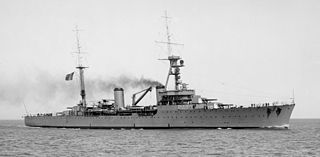
Tourville was the second ship of the Duquesne class cruisers of the French Navy. During the interwar period she served in the Mediterranean while taking periodic cruises to show the Flag. During the war she was on blockade duty in the mid Atlantic then the Mediterranean. She was interned for three years at Alexandria, rejoining the war effort in 1943. Again assigned to blockade duty in the Mid Atlantic at Dakar. Post war she aided in the restoration of French Colonial rule in French Indochina until placed in reserve in 1947. She remained in reserve until condemned for disposal in 1962.
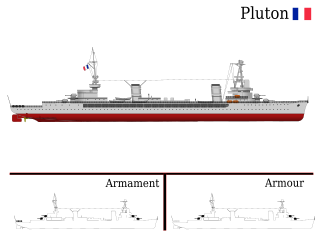
Pluton was a fast minelaying cruiser built for the French Navy in the late 1920s. She was also able to carry 1,000 troops on her mine deck as a fast troop transport. Shortly after completion she was modified and became a gunnery training ship, replacing the elderly armored cruiser Gueydon. Shortly before the beginning of World War II, she reverted to her original role and most of the gunnery training equipment was removed. She was sent to Casablanca, in French Morocco, when the war began to lay a minefield, but the order was cancelled a day later and she was ordered to disembark her naval mines. She exploded while landing her still-fuzed mines on 13 September 1939.
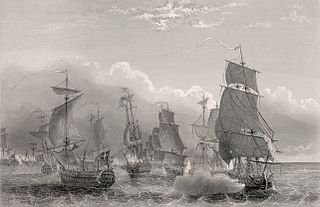
The Battle of Martinique, or Combat de la Martinique, was a naval encounter on 18 December 1779 between a British 13-ship squadron under Admiral Hyde Parker and a three-ship French division under Admiral Lamotte-Picquet near the island of Martinique in the West Indies.

Maillé Brézé was one of six Vauquelin-class destroyers built for the French Navy during the 1930s. The ship entered service in 1933 and spent most of her career in the Mediterranean, sometimes as a flagship. During the Spanish Civil War of 1936–1939, she was one of the ships that helped to enforce the non-intervention agreement. When France declared war on Germany in September 1939, all of the Vauquelins were assigned to the High Sea Forces which was tasked to escort French convoys and support the other commands as needed. Maillé Brézé accordingly spent most of the next six months on escort duties. She played a minor role in the Norwegian Campaign before she was lost in an accidental explosion in April 1940. Most of her crew survived the incident; her wreck was not salvaged until 1954 and was subsequently scrapped.
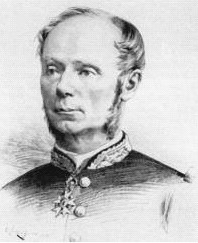
The French Far East Squadron was an exceptional naval grouping created for the duration of the Sino-French War.
The French destroyer Jaguar was a Chacal-class destroyer (contre-torpilleur) built for the French Navy during the 1920s. She spent most of her pre-World War II career as a flagship for various destroyer units. The ship was assigned convoy escort duties in the Atlantic after the start of the World War II in September 1939 until she was badly damaged during a collision in January 1940. Five months later, after her repairs were completed, she was committed to the English Channel after the Battle of France began in May 1940. Jaguar was torpedoed by German E-boats on 23 May and had to beach herself; her wreck was written off as unrepairable.

The La Motte-Picquet class were a planned series of light cruisers for the French Navy and named after French admiral Toussaint-Guillaume Picquet de la Motte. Although designed in 1912, the scheduled construction of La Motte-Picquet was suspended due to the outbreak of World War I before the ships could be laid down. The design would be revived and used as the basis for the Duguay-Trouin class after the war. The name of the planned 1912 lead ship, would be reused by the French cruiser Lamotte-Picquet.
